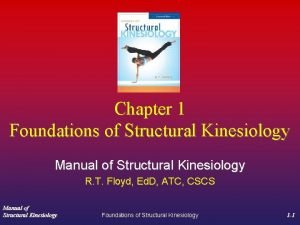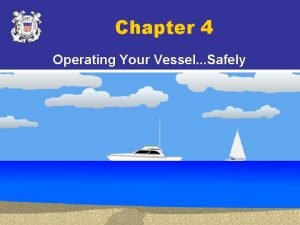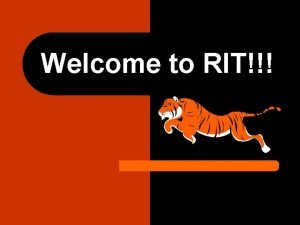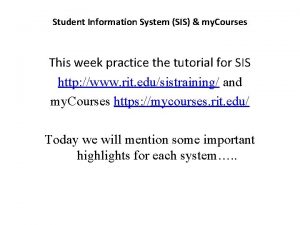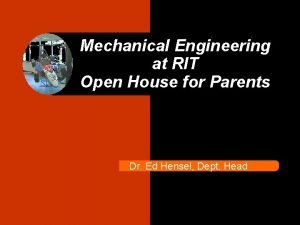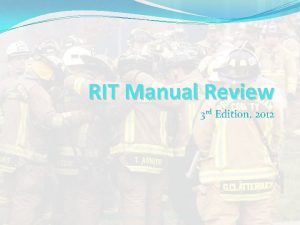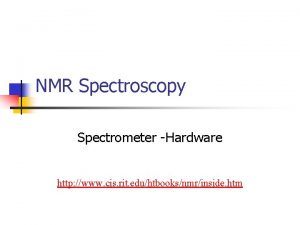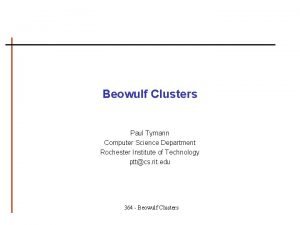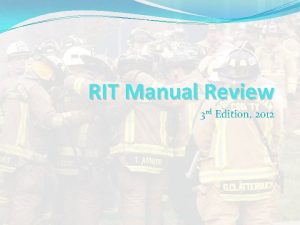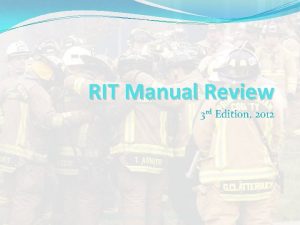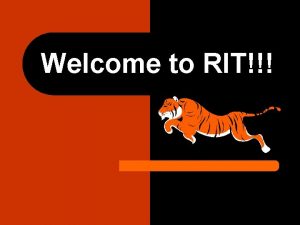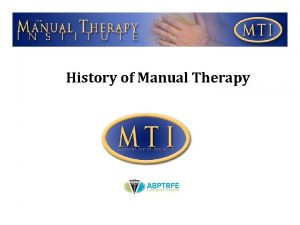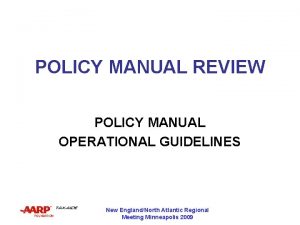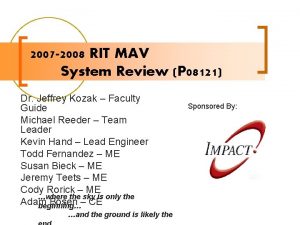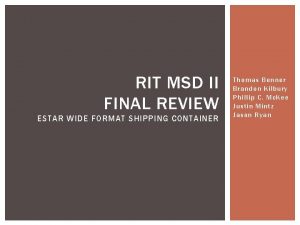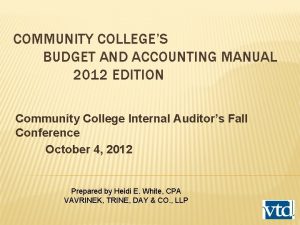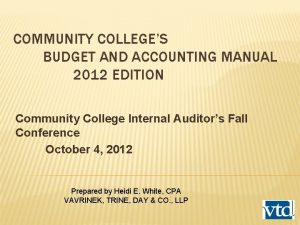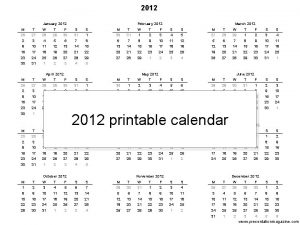RIT Manual Review 3 rd Edition 2012 In



































- Slides: 35

RIT Manual Review 3 rd Edition, 2012 In memory of Technician I Kyle Wilson

IN MEMORY OF TECHNICIAN I KYLE WILSON APRIL 16, 2007

2011 -2012 Committee Members � Arlington County: Matthew Cobb, Captain � City of Fairfax: John Ahrens, Battalion Chief � City of Fairfax: Shawn Dunstan, Captain � Fairfax County: Barry Maham, Captain � Fairfax County: Ray Griffin, Captain � Loudoun County: Derrick Crawford, Captain � MWAA: Jeremy Pope, Captain � Prince William County: Wayne Moran, Captain � Stafford County: Joseph Charley, Battalion Chief In memory of Technician I Kyle Wilson

SIGNIFICANT CHANGES � Increased RIT resources (Initial RIT, RIT Levels 1, 2, 3) � Changed terminology � Changed manual organization � New MAYDAY procedures � Added command & emergency communication procedures � Minimal standard for RIT Training � Regional RIT sticker � Training & survival techniques removed In memory of Technician I Kyle Wilson

Working Structure Fire Defined as a fire incident in a structure where more than one attack line will be deployed from pumping apparatus to combat the fire. An attack line is to be considered deployed when it is removed from the pumping apparatus. In memory of Technician I Kyle Wilson

MAYDAY Mayday – term used to report situations where a firefighter(s) is/are in distress or may require assistance in an IDLH. When to report a MAYDAY? As soon as you realize that you are at risk or lost, communicate with your crew and command with a “MAYDAY” and your best possible location in the building. In memory of Technician I Kyle Wilson

How to Call A MAYDAY? Initial MAYDAY transmission should include the following; Mayday, Mayday Unit number three times, (i. e. Engine 407, Engine 407) Command acknowledge In memory of Technician I Kyle Wilson

How to Call A MAYDAY? �Once acknowledged by command, provide the following; � Position and name � Location � Nature of emergency � Command acknowledge In memory of Technician I Kyle Wilson

How to Call A MAYDAY? �If not acknowledged by command, perform/transmit the following; � � � � Activate the Emergency Activation Button (EAB), if possible Activate your PASS device and briefly key your portable to get attention of other firefighters or command. Deactivate your PASS whenever communicating via radio and reactivate once complete. Mayday, Mayday Unit number three times, (i. e. Engine 407, Engine 407) Location Nature of emergency Mayday, Mayday Command acknowledge In memory of Technician I Kyle Wilson

Command Procedures **The incident commander has the ability to change assignments as the incident dictates** �Initial actions upon receiving a Mayday call � Acknowledge the mayday and immediately deploy the RIT resources to the last known location � Make a fire ground announcement to communicate emergency traffic only and all personnel shall maintain their current positions/assignments � Confirm pertinent information from the downed firefighter (i. e. UCAN or LUNAR) � Request accountability of crew that initiated the mayday � Ensure the dispatch of a RIT Level 2, additional alarms/resources, etc � Initiate a PAR check to confirm accountability of personnel In memory of Technician I Kyle Wilson

Command Procedures �Additional action after receiving a mayday call � Backfill the initial RIT for continued fireground operations � As the situation dictates and resources become available consider additional radio channels � Revise IAP and incident priorities to a high priority search and rescue operation � Develop a rescue action plan (consider/request additional resources) � Withdraw and control unassigned resources from the search and rescue area (control/restrict entry) In memory of Technician I Kyle Wilson

Additional Considerations Consider the need for a staff officer for notification to family members In memory of Technician I Kyle Wilson

Command Activated Deployment of RIT w/out a Mayday Call Initiated Command should initiate a RIT deployment in lieu of a mayday when he/she deems necessary. Examples: Unit resource missing after a PAR Structural collapse with possible entrapment Observes units/personnel in distress In memory of Technician I Kyle Wilson

�Initial RIT Levels Single resource from the initial alarm � Designated in each emergency operation manual � Recommended Four personnel with a minimum of Three This is equivalent to the old Level 1 RIT � �RIT Level 1 (Dispatched ahead of additional alarms) 1 Engine, 1 Special Service (preferably a heavy rescue) � In addition to the initial box alarm � Shall be requested by the initial IC or first due command officer once deemed a working structure fire � May be initiated while responding if supplemental information dictates � Once these units arrive they will be referred to as the “RIT Group” � Officer of the Initial RIT will become the “RIT Group Supervisor” � May request additional resources through the incident commander if necessary � In memory of Technician I Kyle Wilson

RIT Levels RIT Level 2 1 Engine, 1 Truck, 1 Heavy Rescue, 1 Battalion Chief, 1 ALS Unit In addition to the initial box alarm and RIT Level 1 resources These units will arrive and augment the RIT Group Mandatory on any incident involving a lost or trapped firefighter RIT Level 3 (Collapse Rescue) 2 Rescues or units with structural collapse capabilities, a response unit with shoring capabilities RIT Level 2 must have already been requested to ensure adequate resources In memory of Technician I Kyle Wilson

Initial RIT Planning � A primary responsibility is proactive tasks to improve the safety of firefighters working in an IDLH � DO NOT COMMIT TO ANY OPERATION THAT WILL PREVENT YOU FROM MAINTAINING READINESS � Placement of ground ladders � Placement of lighting � Force open exterior doors � Remove window obstructions � Confirm utilities have been controlled � Initial RIT officer shall report to the command post and confer w/ the IC (unless impractical) � Establish tool staging area � Added minimum equipment � Plan where to acquire a protective hoseline if needed � Perform a recon lap � Monitor radio traffic In memory of Technician I Kyle Wilson

Initial RIT Actions Upon activation to a known Mayday situation the Initial RIT should; Search, recon, and locate lost/trapped firefighters Remove the firefighter to a safe location if possible and provide an air supply Communicate w/ command on resources required to protect and rescue the trapped firefighter In memory of Technician I Kyle Wilson

RIT Level 1 Planning �Report to and confer w/ the Initial RIT officer � Develop and implement the Rescue Action Plan � Recon team � Rescue Team � Relief Crew � Ensure the Initial RIT pre-deployment actions have been completed � The tool cache should be built up as the RIT capability is expanded � Deploy a protective hose line if needed for rescue In memory of Technician I Kyle Wilson

RIT Level I Actions Support the objectives of the Initial RIT In memory of Technician I Kyle Wilson

RIT Level 2 Planning �Should confer w/ the IC and the RIT Group �The BFC on this assignment will become the RIT Group Supervisor (IC may use the second BFC from the initial alarm) �Review, develop, and implement the rescue action plan, ensure pre-deployment actions have been completed �Assess the need for additional relief crews assigned to the RIT group and stage them outside the rescue area In memory of Technician I Kyle Wilson

RIT Level 2 Actions �The following actions should take place when activating a RIT Level 2: � Assignment of BFC or command officer as the RIT Group Supervisor � Assignment of a separate radio channel for RIT, if possible � Coordinate rescue operations w/ firefighting operations � Identify support needs and request additional resources from the IC � Identify or create access openings to the trapped firefighters � Develop the capability to supply air to trapped firefighters from all jurisdictions involved � Anticipate patient extrication requirements � Anticipate patient packaging and removal requirements � Assign ALS units In memory of Technician I Kyle Wilson

RIT Level 3 Planning Should confer with the IC and the existing RIT Group Review rescue action plans, further develop them, and implement building collapse action plans In memory of Technician I Kyle Wilson

Building Collapse Action Plan The building collapse action plan should include or consider the following elements: Maintain suppression control operations (if applicable) Perform hazard assessment Fire acceleration Utility involvement Secondary collapse potential Hazardous materials involvement Implement hazard control requirements (utility control, monitoring, shoring, etc) Assign units to assure adequate lighting in rescue area In memory of Technician I Kyle Wilson

RIT Level 3 (Collapse Rescue) Actions � Assign technical rescue group by technical rescue qualified officer � Assign a technical rescue safety officer by technical rescue qualified personnel � Consider an additional channel for RIT Level 3 logistical operations � Initiate operations to rescue surface victims and lightly trapped victims � Expand search parameters established during previous RIT levels � Identify support requirements and request resources from IC � Initiate operations to perform heavy rescue requirements � Breaching � Lifting � Specific debris removal � General rubble clearance � Utilization of heavy equipment � Maintain a RIT capability while rescue operations are performed � Consider a physician. Inresponse to the. I Kyle scene memory of Technician Wilson

Rapid Intervention Team Recon Procedures • Upon activation, should deploy to the last known location • Locate, provide air, and secure a tag line in the area of the downed firefighter • Determine additional resources • Begin packaging and removal, if possible In memory of Technician I Kyle Wilson

RIT Rescue Procedures �After the RIT Recon has located the firefighter, the following information should be relayed to the RIT Group Supervisor � Location � Disposition � Best access � Crew disposition � Additional resources needed �RIT Group Supervisor may deploy additional RIT’s w/ a minimum of 3 personnel in each �Crews should be familiar w/ ROAM �ROAM should be tracked by the RIT Group Supervisor or aide �Rescue & removal is the responsibility of the RIT Rescues In memory of Technician I Kyle Wilson

Rapid Intervention Team Relief Procedures Average 8 minutes to locate a lost or downed firefighter and 22 minutes to remove that firefighter RIT Group Supervisor must ensure adequate relief crews are available to support the rescue action plan Coordinate this well in advance, and through the IC In memory of Technician I Kyle Wilson

Firefighters/Officers/Unit Responsibilities This section is intended to address the expectations of all units on the incident scene Maintain radio discipline Communicate emergency traffic only Ensure accountability of your crew Prepare for a PAR Continue w/ current assignment Search immediate area for missing or downed firefighter Face to face communication w/ other units operating in the immediate vicinity In memory of Technician I Kyle Wilson

ECC Responsibilities Dispatch Procedures Dispatch RIT Level I when requested by the Incident Commander or on-scene/responding command officer Units shall be identified upon dispatch as RIT levels Advise the incident commander once the RIT levels have been dispatched Maintain radio discipline In memory of Technician I Kyle Wilson

ECC Responsibilities (cont) � Dispatch Procedures Following a Mayday � Ensure the IC acknowledged the mayday call � If the dispatcher receives a mayday from an individual not operating on the assigned channel/zone � Gather LUNAR/UCAN information from the firefighter � Do not have firefighters attempt to switch channels � Contact jurisdiction and/or incident commander in which the incident is occurring and provide the above information � Maintain open communication w/ the firefighter calling the mayday and jurisdictions operating at the incident � Dispatch RIT Level 2 when requested by the initial incident commander or responding command officer � This dispatch will take precedence over any additional alarms � Advise the incident commander that a RIT level 2 has been dispatched � Maintain radio discipline � Assign a dispatcher to closely monitor all radio traffic on the tactical channel � Notify surrounding jurisdictions involved in the incident of the event � Do not initiate operational responsibilities until directed by the IC (i. e. emergency evacuation tones, RIT deployment tones, etc) In memory of Technician I Kyle Wilson

Regional RIT Tracking Board Side “A” In memory of Technician I Kyle Wilson

Regional RIT Tracking Board Side “B” In memory of Technician I Kyle Wilson

REGIONAL RIT STICKER In memory of Technician I Kyle Wilson

SUMMARY In memory of Technician I Kyle Wilson

QUESTIONS? In memory of Technician I Kyle Wilson
 Using mis 10th edition
Using mis 10th edition Chapter 1
Chapter 1 Manual of structural kinesiology 18th edition
Manual of structural kinesiology 18th edition Engineering economy 16th edition solution manual chapter 5
Engineering economy 16th edition solution manual chapter 5 Engineering economy 16th edition solution manual chapter 5
Engineering economy 16th edition solution manual chapter 5 Engineering economy 16th edition solution
Engineering economy 16th edition solution Boating manual chapter 4 review
Boating manual chapter 4 review Chapter review motion part a vocabulary review answer key
Chapter review motion part a vocabulary review answer key Uncontrollable spending ap gov
Uncontrollable spending ap gov Narrative review vs systematic review
Narrative review vs systematic review Systematic review definition
Systematic review definition Narrative review vs systematic review
Narrative review vs systematic review Project lead the way
Project lead the way Rit mechanical engineering
Rit mechanical engineering Rit academic success center
Rit academic success center My courses rit
My courses rit Rit emotional support animal
Rit emotional support animal Rit srate
Rit srate Rit free electives
Rit free electives Sean strout
Sean strout Que es el rit
Que es el rit Rit microelectronic engineering
Rit microelectronic engineering Rit srate
Rit srate Bạn bè ríu rít tìm nhau
Bạn bè ríu rít tìm nhau Risa robinson rit
Risa robinson rit Rit
Rit Rit nrh post office
Rit nrh post office Rit golisano floor plan
Rit golisano floor plan Ecc rit
Ecc rit Heilmeier catechism
Heilmeier catechism Python
Python Rit
Rit Britt stanford rit
Britt stanford rit Rit disability services
Rit disability services Rit cs clusters
Rit cs clusters How do you spell studios
How do you spell studios


